Digital Poster
Interventional MRI: Sound & Temperature
ISMRM & ISMRT Annual Meeting & Exhibition • 10-15 May 2025 • Honolulu, Hawai'i

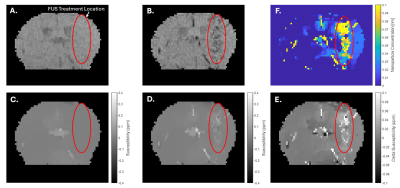 |
Computer Number: 81
2181. Quantitative
Susceptibility Mapping to Measure Focused Ultrasound-Mediated
Delivery of Size-Variable Model Drugs to the Brain
M. Hoch, T. Ho, R. Price, G. Miller
University of Virginia, Charlottesville, United States
Impact: This study offers a new tool to measure the
FUS-mediated delivery of molecules within the size range of
common neurotherapeutics, enabling both clearer
interpretation of therapeutic outcomes and size-specific
dosage and treatment planning in both pre-clinical and
clinical settings.
|
|
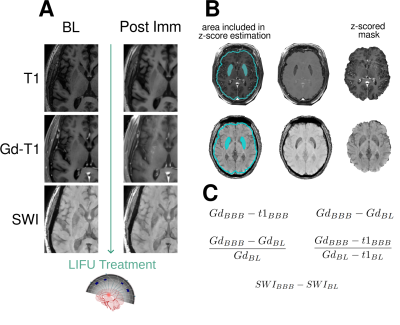 |
Computer Number: 82
2182. Dose-Response
in BBB Opening via MRgFUS using subharmonic measurements of
cavitation dose (SCD) and Contrast Enhanced (CE) MRI-derived
metrics.
M. Castillo, C. Gasca-Salas, M. Álamo, J. Blesa, J.
Grinfeld, I. Rachmilevitch, J. A. Obeso, J. Pineda-Pardo
HM CINAC, MADRID, Spain
Impact: This study highlights a promising relationship
between MRI-derived metrics and real-time cavitation dose
measured by hydrophones during LIFU. This insight could
enable dynamic adjustments during treatment, improving BBBO
monitoring and potentially enhancing treatment efficacy and
safety.
|
|
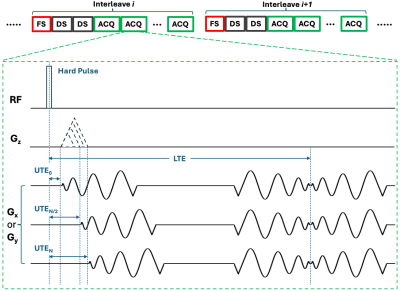 |
Computer Number: 83
2183. An
Improved 3D Stack-of-Spirals Sequence for Simultaneous Brain and
Skull Thermometry in Clinical Transcranial MRgFUS Surgery
S. Chen, S. Allen, J. Mugler III, W. Elias, G. Miller, C.
Meyer
University of Virginia, Charlottesville, United States
Impact: The
proposed sequence that features fat suppression, variable
UTE, and a retraced-spiral-in-and-out trajectory should
improve accuracy in simultaneous brain (PRF-based) and skull
(T1-based) thermometry in a clinical setting and is
promising in monitoring unintended heating during clinical
transcranial MRgFUS surgery.
|
|
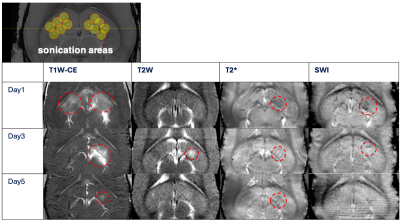 |
Computer Number: 84
2184. Assessing
Blood-Brain Barrier Opening and Safety in Rats during Focused
Ultrasound Procedure with MRI and Acoustic Cavitation Monitoring
T. Xiao, K. Kim, K. Narsinh, E. Ozhinsky
University of California, San Francisco, San Francisco, United States
Impact: The optimized BBB opening and monitoring
protocol developed in this study will enable preclinical
studies of delivery of the therapeutic compounds across the
BBB.
|
|
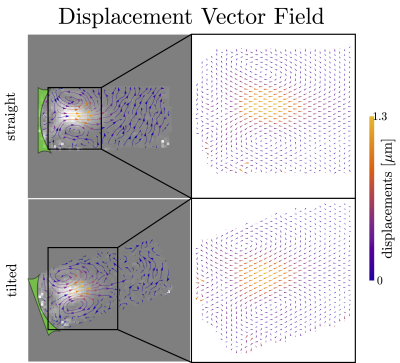 |
Computer Number: 85
2185. Displacement
Vector Field Imaging
S. Hodono, M. Cloos, D. Norris
Radboud University, Nijmegen, Netherlands
Impact: Displacement Vector Field Imaging enables the
visualization of displacements induced by transcranial
ultrasound by quantifying both magnitude and angle. Improved
measurements of the detailed interactions of pressure waves
and medium can aid precise targeting in neuromodulation
studies.
|
|
 |
Computer Number: 86
2186. The
Effects of Image Filtering on the Accuracy and Precision of
Magnetic Resonance Hydrophone Measurements
S. Allen, D. Cavinatto, C. Reed, P-E Passe-Carlus
Brigham Young University, Provo, United States
Impact: This study will inform future users of MR
hydrophone techniques of the basic tradeoffs image filtering
imposes on measurement accuracy and precision.
|
|
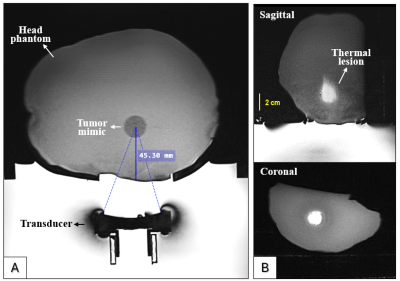 |
Computer Number: 87
2187. Focused
Ultrasound sonications in a tumor-bearing head phantom within a
high field MRI scanner
A. Antoniou, N. Evripidou, L. Georgiou, A. Chrysanthou, A.
Christofi, Y. Roussakis, C. Ioannides, C. Damianou
Cyprus University of Technology, Limassol, Cyprus
Impact: This research provides initial insights into
utilizing a thin, biocompatible implant to temporarily
replace a segment of the skull, enabling MRgFUS ablation of
inoperable brain tumors with a single-element transducer and
presenting potential clinical benefits, pending further
feasibility studies.
|
|
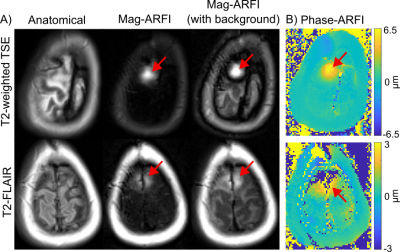 |
Computer Number: 88
2188. Magnitude-Contrast
MR-ARFI (Mag-ARFI): Subtraction-free MR-ARFI with inherently
fused ultrasound focus and anatomy
A. Sharma, K. Zarcone, W. Grissom
Case Western Reserve University, Cleveland, United States
Impact: MR-ARFI suffers from phase errors that obscure
the ultrasound focus, and requires separate anatomical
imaging to display the focus overlaid with anatomy. We
present a single-acquisition method to produce physiological
motion-robust MR-ARFI images with inherently fused
ultrasound focus and anatomy.
|
|
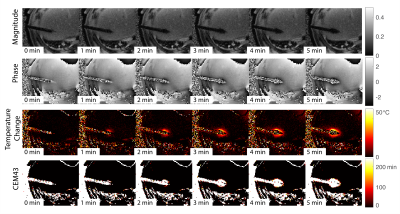 |
Computer Number: 89
2189. Real-time
MR Thermometry to Monitor Microwave Ablation: Validation in
Oncopigs using Immediate Post-Ablation MRI and Gross Pathology
Q. Dai, J. Chiang, G. Nyborg, S-F Shih, D. Lu, H. Wu
University of California, Los Angeles, Los Angeles, United States
Impact: The experimental setup using the Oncopig cancer
model demonstrates a promising preclinical framework for
developing, validating, and refining MR thermometry
techniques to improve MRI-guided MWA for better outcomes.
|
|
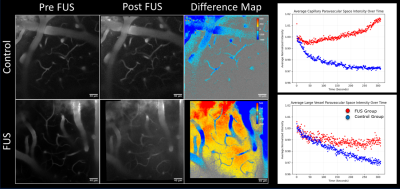 |
Computer Number: 90
2190. Characterizing
Focused Ultrasound-Induced Changes using 2-Photon Microscopy and
MRI in a Mouse Model of Alzheimer’s Disease.
D. Murphy, A. Samoy-Alvarado, C. Little, R. Carlson, C.
Howison, T. Matsunaga, U. Utzinger, P. Pires, E. Hutchinson,
T. Trouard
University of Arizona, Tucson, United States
Impact: DCE imaging and sub-micron imaging of the
microvasculature after BBB opening provide insight into
which vessels are opened after FUS and improve
pharmacokinetic understanding of the paravascular space in
an Alzheimer’s Disease model.
|
|
 |
Computer Number: 91
2191. Pre-operative
diffusion metrics associated with long-term tremor outcome
following MR-Guided Focused Ultrasound Thalamotomy
C. Rockel, D. Clark, A. Sereshki, C. Aquino, F. Girgis, T.
Sankar, S. Pichardo, D. Martino, Z. Kiss, G. Pike
University of Calgary, Calgary, Canada
Impact: The DRTT contralateral to the surgical target
plays an undetermined role in the long-term effectiveness of
MRgFUS thalamotomy for Essential Tremor, particularly in
cerebellar regions. Future research into tremor
understanding and treatment should consider anatomy outside
of direct pathways.
|
|
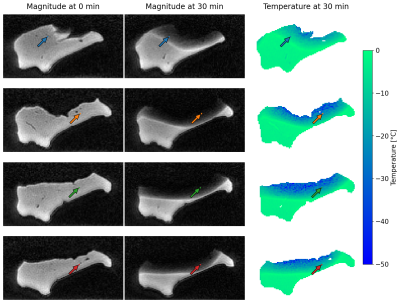 |
Computer Number: 92
2192. Temperature
Mapping During MR-Guided Cryoablation Using a FLORET UTE
Sequence
M. Gutt, O. Belker, J. Scheller, S. Schröer, F. Wacker, B.
Hensen, M. Gutberlet
Hannover Medical School, Hannover, Germany
Impact: During MR-guided cryoablation of tumors the
proposed method could be used for therapy monitoring. It
could thus enable a safer and more targeted way of
destroying the tumor but not too much of the surrounding
healthy tissue.
|
|
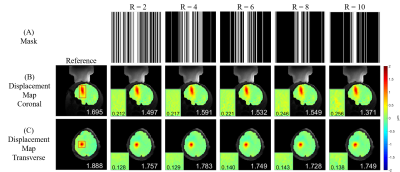 |
Computer Number: 93
2193. Fast
magnetic resonance acoustic radiation force imaging with high
under-sampling rate.
Y. Yuan, Z. Xu, Y. Liu, X. Long, W. Liu, H. Zheng, C. Zou
Shenzhen Institute of Advanced Technology, Chinese Academy of Sciences, Shenzhen, China
Impact: The proposed method can be exploited to achieve
fast MR-ARFI at high under-sampling rate to reduce the
ultrasound deposition and shorten the scanning time, which
is crucial for the safety concern of ARFI application in
human study.
|
|
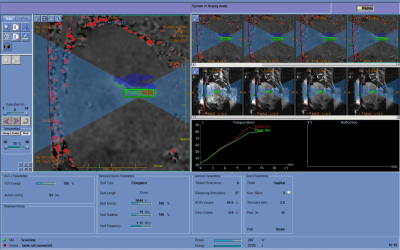 |
Computer Number: 94
2194. The
Study of Magnetic Resonance-Guided High-Intensity Focused
Ultrasound (MRgFUS) Treatment for Adenomyosis
Q. Zhang, Y. Shen, L. Xu, J. Zhang, P-Y Wu
Huashan Hospital, Fudan University, Shanghai, China
Impact: MRgFUS is safe and effective in the treatment of
uterine adenomyosis, and is a new non-invasive treatment
approach.
|
|
 |
Computer Number: 95
2195. Comparing
Stack-of-Stars and Stack-of-Spirals Sequences for PRFS based 3D
MR Thermometry to monitor Hepatic Microwave Ablation
D. Horstmann, B. Hensen, O. Belker, D. Düx, T. Gerlach, M.
Gutt, S. Schröer, I. Vogt, F. Wacker, M. Gutberlet
Hannover Medical School, Hannover, Germany
Impact: Stack-of-Spirals demonstrates potential for
clinical real-time 3D thermometry, improving ablation
success in moving abdominal organs through precise
monitoring. This could enhance patient safety, establish new
imaging standards, and open avenues for broader application
in thermal therapies.
|
|
 |
Computer Number: 96
2196. Monitoring
accurate MR guided focused ultrasound hyperthermia treatments
with a k-space based B0 correction thermometry technique
S. Johnson, B. Nelson, P. Guenkawa, E. Dumont, J. Roberts,
D. Parker, H. Odéen, A. Payne
University of Utah, Salt Lake City, United States
Impact: Accurate MR thermometry is critical to the
successful delivery of hyperthermia treatments, where a
fraction of degree accuracy can impact treatment outcome.
Implementing a k-space based B0 correction technique
achieves substantially improved accuracy in MR guided
focused ultrasound hyperthermia treatments.
|
The International Society for Magnetic Resonance in Medicine is accredited by the Accreditation Council for Continuing Medical Education to provide continuing medical education for physicians.